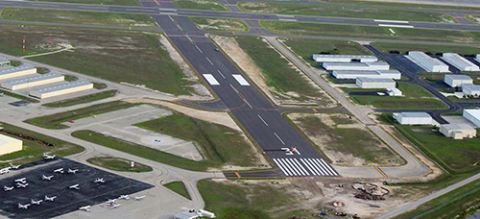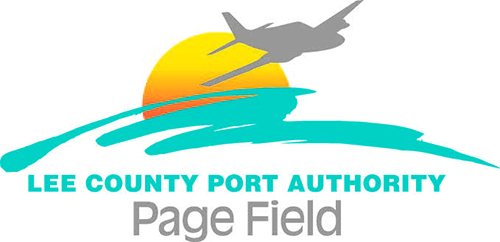Page Field Upgrades Runways & Taxiways, Adds Energy-Efficient Airfield Lighting

There’s never a good time to close runways and taxiways for rehab work. But thanks to an intense coordination effort, Page Field (FMY) in Fort Myers, FL, completed a nearly $30 million airfield project last year with minimal disruptions to flight operations. Crews repaved the airport’s two runways, upgraded several taxiways and installed a new airfield lighting system in 19 months, despite imposing weather challenges that included Hurricane Irma in September 2017.
Key participants credit the decision to use GPS-controlled grading and paving equipment for helping the team complete the extensive project on time and under budget by about $1.5 million. That cost savings allowed the airport to rehab an extra 1,500 feet of a taxiway, notes Scott Sheets, director of general aviation for the Lee County Port Authority, which owns and operates FMY.
Work was strategically staged in two phases to keep at least one runway open for almost the entire project, which ran from January 2017 through late August 2018. As such, the airport suffered minimal revenue losses, Sheets reports.
|
Project: Airfield Improvements Scope: Repaving 2 runways & several taxiways; installing new lighting system with LED lights & signs Location: Page Field—Fort Myers, FL 2018 Annual Operations: 97,816 Project Cost: Nearly $30 million Main Runway/Taxiways Funding: 90% FAA; 5% state; 5% Lee County Port Authority Main Runway Length: 6,406 ft. Crosswind Runway & Taxiway Funding: 80% state, 20% port authority Crosswind Runway Length: 4,909 ft. Construction Timeline: Jan. 2017-late Aug. 2018 Primary Airfield Lighting Components: 122 LED runway edge lights; 757 taxiway lights; 56 LED threshold lights; 139 LED signs; 85 junction can plazas; new airfield vault; about 100,000 ft. of conduit/duct work; 297,000 ft. of lighting cable Lights/Signs: ABD Safegate Junction Cans: Jaquith Industries Inc. Closures: 107 days for main runway, 313 days for crosswind runway Airfield Lighting Design: AVCON Inc. Project Design/Engineering: Hole Montes Inc.
Construction Management:
Paving Contractor: Ajax Paving Industries
Earthwork Subcontractor: GPS-Guided Equipment: Topcon Corp. Electrical Contractors: H.L. Pruitt Corp.; Baja Electric Service Inc. Drainage/Site Work: Gulf Coast Underground; Christo Inc. Key Benefits: Minimal operational disruption & revenue loss; improved runways; better airfield visibility/lighting quality; easier, safer lighting repair & troubleshooting; lower energy costs |
The main runway closed for 107 days between mid-April and early August 2017. The crosswind runway was shut down for 313 days between late August 2017 and early July 2018. Both were closed for a five-day span in early June 2017 when crews repaved their intersection, plus a couple nights about one month later to groove the new pavement and paint runway markings.
Many Moving Pieces
During the first phase of the project, crews completed a 4-inch mill-and-overlay of the main runway, which is 6,406 feet long. They also repaved portions of two parallel taxiways and several associated connectors and removed, realigned, relocated and reconstructed other sections. The FAA paid 90% of the $21.1 million tab, with the Florida Department of Transportation (FDOT) and the port authority kicking in another 5% each.
The second phase, begun in late October 2017, focused primarily on a 2-inch mill-and-overlay rehabilitation of the middle 100 feet of the 4,909-foot-long crosswind runway. In addition, crews reconstructed the outer 25 feet on both sides of the crosswind runway.
This phase also included repaving one parallel taxiway and extending another to a full-length taxiway. FDOT paid for 80% of the $8.8 million cost, and the port authority covered the balance.
“The pavement on both runways badly needed rehabilitation,” says Sheets. “The last rehab work on the main runway was a mill-and-overlay project in 1996; so it was due for improvements.”
The project also upgraded all airfield lighting and signage to light-emitting diode (LED) fixtures manufactured by ADB Safegate. Sheets reports the new LED lighting has decreased the airport’s energy usage by about 55%, even though there are more signs and lights now than before the project.
“That equates to about $12,000 in savings annually,” he says. “That’s not a huge number, but it’s significant for us.”
GPS-Guided Machines Cut Costs
During a brainstorming session shortly after the project began, executives from Ajax Paving suggested using GPS-guided earthmoving and paving equipment for the project—a move that ended up saving the airport $1.5 million by reducing the amount of materials such as asphalt and gravel that were used.
“To my mind, this made the project an even bigger success,” says Tim Parker, senior project manager with project designer/engineer Hole Montes. “It was a big deal because the total cost came in $1.5 million under budget. That allowed the airport to spend another $756,000 to rehab an additional 1,500 feet of a taxiway, which was part of a future planned phase of rehabilitation. So the airport actually got more work performed than what was in the original plan, plus it achieved a net under-budget savings of about $744,000.”
When contractors use conventional manually controlled machines, they typically apply extra material because they don’t want to get “dinged” for applying thinner layers than what’s required in the project specifications, Parker explains. GPS-controlled equipment applies materials to within a quarter-inch of specified tolerances, which results in significantly less material used.

In addition, site preparation goes faster because there’s no need to manually place grading stakes or create string lines for machine operators to follow.
“We essentially ‘built’ a three-dimensional CADD (computer-aided design and drafting) drawing of all the surfaces in the project—about 20 surfaces in all,” explains Ajax GPS Survey Manager Jacob Amann. “Then we used that and some traditional surveying methods to set up a GPS network, similar to an Internet network, on the job site.”
After that, the CADD files were loaded via flash drive onto machines such as bulldozers, graders and pavers equipped with millimeter GPS devices made by Topcon Corp. In simplest terms, those devices “talk” to laser transmitters throughout the jobsite.
“This network set up all the design elevations and enabled us to achieve elevations and slopes to within a quarter-inch of the design specifications, which eliminated a lot of waste,” Amann says. “When the machines get within 3 inches of the design parameters, they go on automatic control and basically just follow the CADD design.”
Coordination Was Critical
Aside from bad weather, keeping all affected parties in the loop and soliciting their input when unexpected obstacles emerged proved to be the most challenging aspects of the project. Key stakeholders included the airport’s self-run fixed-base operator (Base Operations at Page Field), tower personnel, businesses that use the airport, private pilots, airport tenants, contractors and subcontractors.
“The biggest challenge was coordination,” Sheets says. “We were disrupting the majority of the airport at one point or another; so just coordinating between the airport, the general contractors, tenants, the tower and subcontractors was a challenge.”
Airport officials held town hall-style meetings with tenants to develop a phasing program and get them on board early in the process. “The taxi routes became very complex at times because of the various closures taking place around the airport,” Sheets recalls. “If things aren’t phased correctly, those closures had the potential to block in private tenants.”
Sometimes, taxi routes had to cross an active runway. “It wasn’t ideal, but at times it couldn’t be avoided,” he reflects.
 When unexpected challenges arose, officials revisited the original plan and tweaked it accordingly. For example, 5 inches of rain fell during the five days that paving work was scheduled at the intersection of the main runway and crosswind runway.
When unexpected challenges arose, officials revisited the original plan and tweaked it accordingly. For example, 5 inches of rain fell during the five days that paving work was scheduled at the intersection of the main runway and crosswind runway.
“We were wondering if we’d get the runways open on time,” Sheets acknowledges. “But the contractors made it happen. We had a very good team. They all deserve a huge tip of the hat.” Contractors on the project included Hole Montes for design and engineering; AVCON Inc. for airfield lighting and vault design; Owen-Ames-Kimball Co. for construction management; H.L. Pruitt Corp. and Baja Electric Service for electrical work; Ongrade Contracting, an earthwork subcontractor; and Gulf Coast Underground and Christo Inc. for drainage and site work.
LED Conversion
Another key component of the project was a new airfield lighting system. The old lighting system included antiquated incandescent and quartz incandescent, stake-mounted lights connected by direct-buried cables. The new system features LED fixtures that use a base-can-and-conduit system.
The system’s major components include 122 LED runway edge lights, 757 taxiway lights, 56 LED threshold lights and 139 LED signs, all made by ADB Safegate. Crews also installed 85 junction can plazas, with cans manufactured by Jaquith Industries; a new airfield lighting electrical vault; and about 100,000 feet of conduit/duct work. The 297,000 feet of lighting cable is routed in a series-circuit configuration to make troubleshooting and repairs easier, notes Carl Johnson, a senior aviation lighting specialist with AVCON.
Junction can plazas work like junction boxes in other electrical systems. Each concrete plaza typically contains two, four or six cans. When technicians perform electrical repairs, they simply reach down into the cans, which are 2 feet deep and 16 inches in diameter. That’s much easier and safer than climbing down into manholes—a process that requires confined space entry permits and extra safety precautions.
Furthermore, each can contains a limited number of circuits. As such, electricians can more easily identify and isolate the circuit that requires work. They also can tell if any additional circuits need to be taken offline for further work. “You can segregate circuits…and damaged circuits can’t damage other circuits,” says Johnson.
Vault Improvements
The new airfield lighting vault facilitates troubleshooting, too. The interior workspace of the previous 1950s vault was very congested after decades of system revisions and updates and no longer adequately supported the airfield lighting system. In addition, the existing lighting circuits featured direct-buried cables that were circuited in large loops, which made troubleshooting difficult, Johnson relates.
 “So we divided the runway circuits into quadrants…and now technicians can start troubleshooting from the vault,” he explains. “Before, they would start in the vault, but once they’d identify the issue, they’d have to go out onto the airfield and start breaking the circuit (loop) into segments to troubleshoot.
“So we divided the runway circuits into quadrants…and now technicians can start troubleshooting from the vault,” he explains. “Before, they would start in the vault, but once they’d identify the issue, they’d have to go out onto the airfield and start breaking the circuit (loop) into segments to troubleshoot.
“Now they can break the runway circuit into two segments in the vault, then go out on the airfield and go to the first can plaza adjacent to the runway and break it in half again. As such, they know which side of the runway to troubleshoot. It’s a big time-saver.”
The taxiway circuits also were reconfigured to make troubleshooting easier. Other upgrades include a control-and-monitoring system for the airfield lighting, operated via touch screens in the control tower, and a monitor in the vault. The control system features an auto-dial component, which automatically notifies maintenance personnel when a lighting problem occurs. The airport also updated the pilot-activated lighting system.
Keys to Success
According to Parker, getting an early start on planning was crucial to the project’s overall success. “This project took a lot of coordination with the port authority, the FAA, FDOT and Owen-Ames-Kimball,” he says. “You can’t let things go out of control. And when we saw opportunities to save time, we went for it. The success of big projects like this often hinges on a bunch of little decisions here and there.”
Assembling a good team also was critical, adds Sheets. “Get your tower, your tenants and everyone else involved early in the process,” he advises.
“This was by far the most complex project I’ve had to oversee in my airport management career,” he adds. “And no matter how much planning you do ahead of time, there always are surprises. You have to be flexible—see what’s working and what’s not working. There were a lot of moving parts out there, so we needed a lot of communication.”
2022 Charlotte Douglas International Airport Report of Achievement
 Giving back to the community is central to what Charlotte Douglas International Airport and its operator, the City of Charlotte Aviation Department, is about, and last year was no different.
Giving back to the community is central to what Charlotte Douglas International Airport and its operator, the City of Charlotte Aviation Department, is about, and last year was no different.
Throughout 2022, while recovering from the COVID-19 pandemic, we continued our efforts to have a positive impact on the Charlotte community. Of particular note, we spent the year sharing stories of how Connections Don't Just Happen at the Terminal - from creating homeownership and employment opportunities to supporting economic growth through small-business development and offering outreach programs to help residents understand the Airport better.
This whitepaper highlights the construction projects, initiatives, programs and events that validate Charlotte Douglas as a premier airport.
Download the whitepaper: 2022 Charlotte Douglas International Airport Report of Achievement.
 facts&figures
facts&figures








